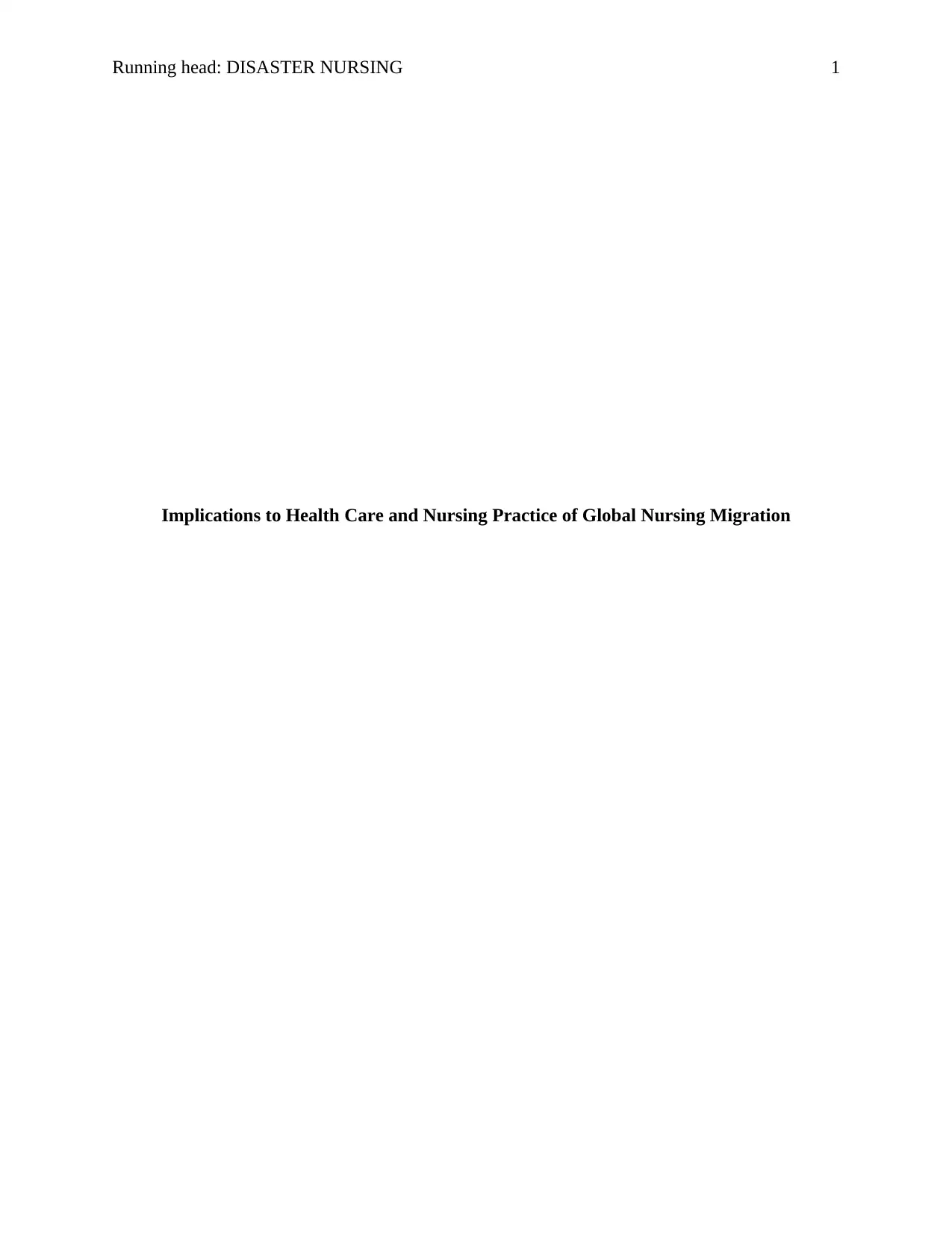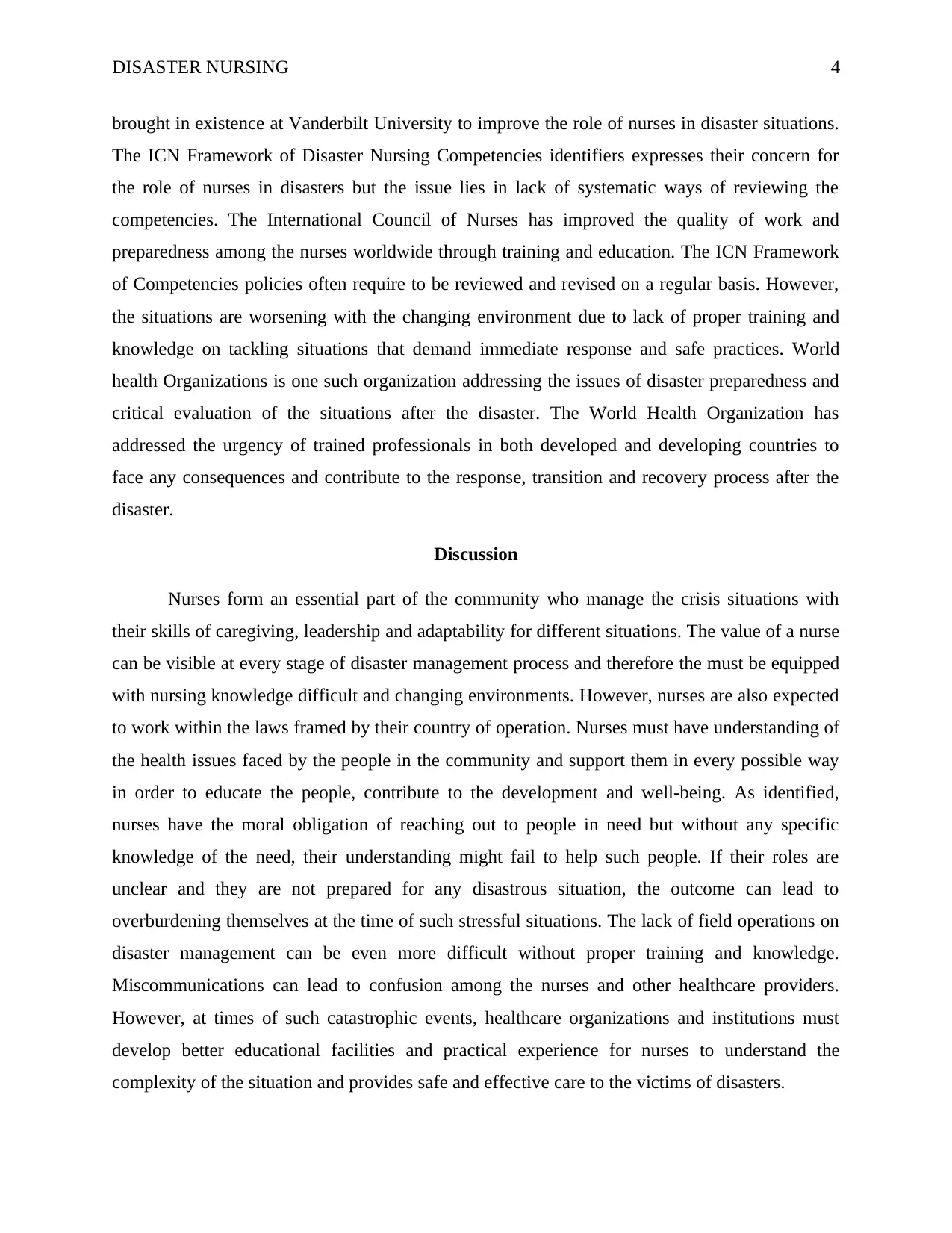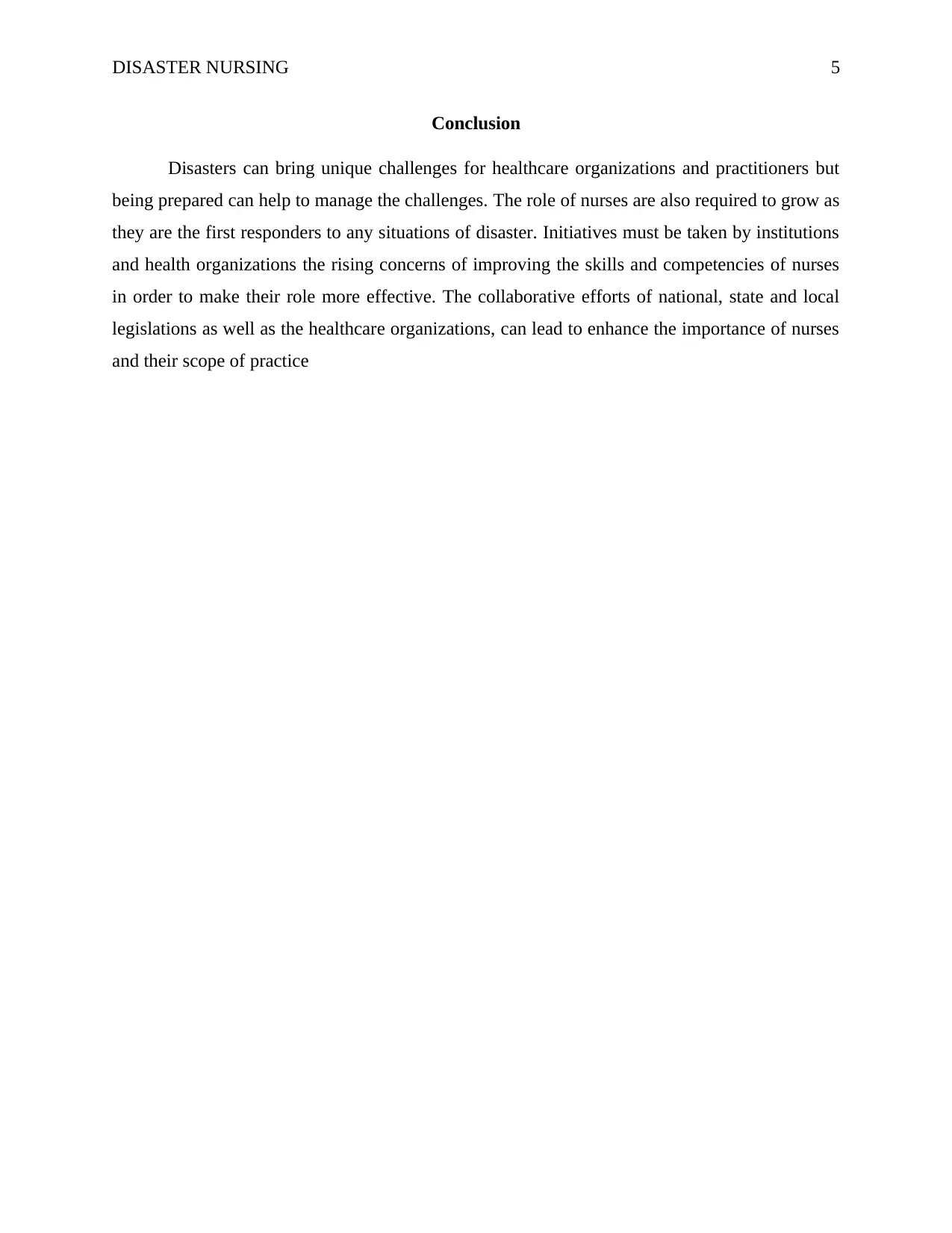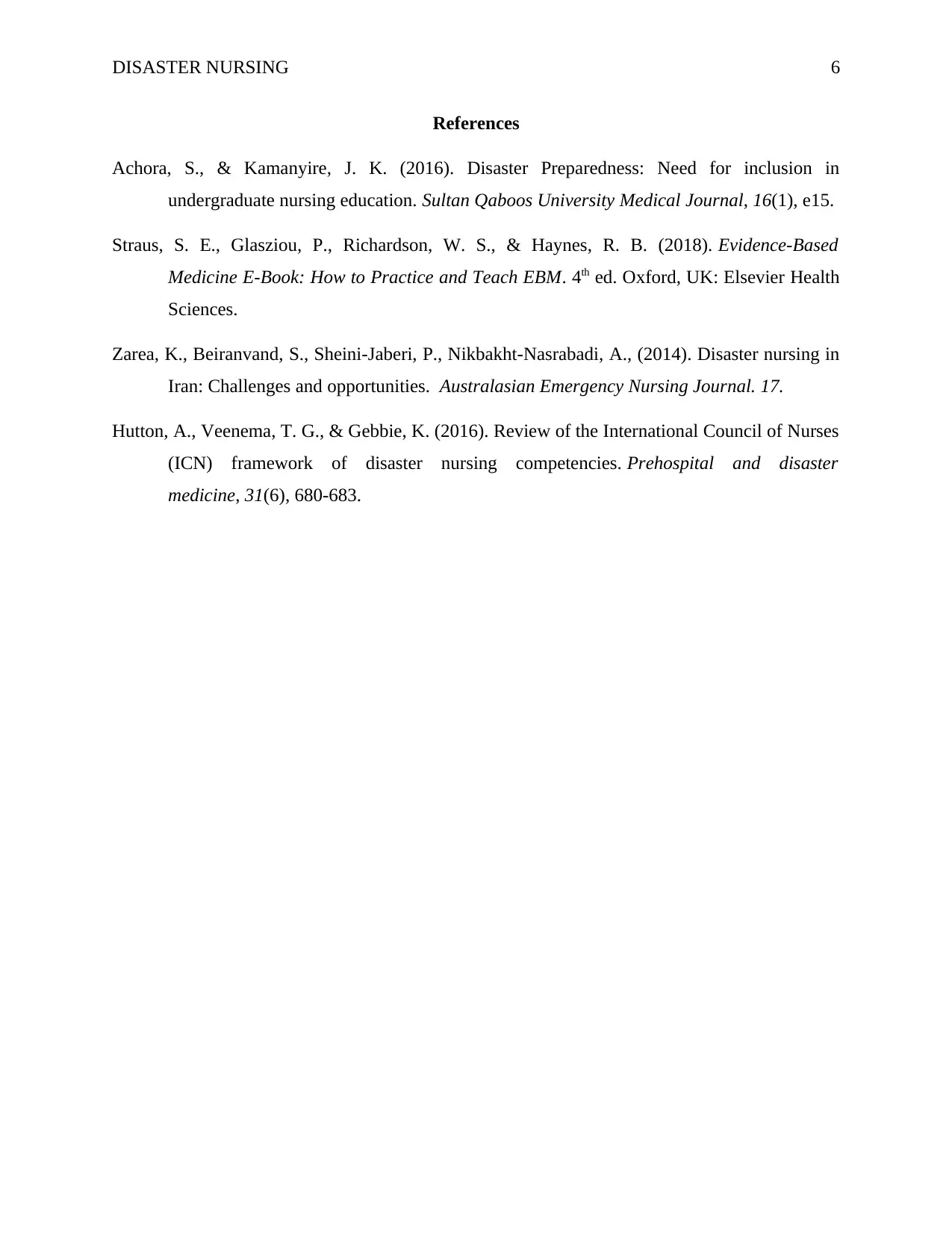Disaster Nursing: Healthcare and Nursing Practice Implications Report
VerifiedAdded on 2023/01/23
|6
|1579
|33
Report
AI Summary
This report critically evaluates the implications of disaster nursing on healthcare and nursing practice, considering international policies. It emphasizes the vital role of nurses as first responders in disaster situations, highlighting their responsibilities in providing physical and mental care, delivering emergency care, and effective communication. The report reviews the literature on disaster preparedness, competency-based education, and the lack of disaster nursing education in many institutions. It also discusses the dynamic nature of nurses' roles during emergencies, the importance of assessing injuries, and the need for clear communication with other healthcare providers. The professional responsibility of nurses includes providing safe and effective care, often extending beyond their scope of practice. The report references the ICN Framework of Disaster Nursing Competencies and the role of WHO in addressing disaster preparedness, emphasizing the need for improved skills, competencies, and collaborative efforts to enhance nurses' roles in disaster management. The report concludes by stressing the importance of preparedness in managing the challenges of disasters and the need for initiatives to improve the skills and competencies of nurses.

Running head: DISASTER NURSING 1
Implications to Health Care and Nursing Practice of Global Nursing Migration
Implications to Health Care and Nursing Practice of Global Nursing Migration
Paraphrase This Document
Need a fresh take? Get an instant paraphrase of this document with our AI Paraphraser

DISASTER NURSING 2
Introduction
A disaster is a catastrophic event that often leads to morbidity and damage to property
and lives. The outcomes of natural and manmade disasters can be devastating leaving the first
hand responders act upon the situations at the earliest. Nurses are one of the first responders at
the disaster scenes, medical centers and hospitals, care of the patients for their quick recovery.
Nurses are generally expected to assist the victims during and after the disaster by way of
physical and mental care. But this often requires skills of delivering lifesaving and emergency
care which is received from learning of disaster preparedness. Nurses must be uniquely qualified
to manage any situation involving emergency care by responding quickly, prioritizing injuries,
effective communication and collaboration with other healthcare providers. The aim of the report
is to critically evaluate implications to healthcare and nursing practice of disaster nursing when
considering a specific International policy related to disaster nursing. The report will evaluate the
role of nursing and their professional responsibility to disasters and safe care of patients.
Literature Review
As opined by Achora & Kamanyire (2016), healthcare professionals are often among the
first people to respond to any disaster which requires them to be prepared for any situation.
Therefore, it becomes essential for healthcare professionals to be disaster prepared in order to
provide safe and effective care to the victims of the disaster. However, as suggested by Straus,
Glasziou, Richardson & Haynes (2018), disaster preparedness has still a long way to go in terms
of skill building and competency based education for nurses and other healthcare responders.
Disasters can occur at any time and emergency services are required to respond to the situations
with their knowledge and abilities to gain maximum control over the situations. Nursing practice
involves providing care to the injured, assist them and their families to deal with the issues
contribute to well-being of the society. Since nurses are expected to be involved in the disaster
planning phases and contribute to the response to the disasters, it is vital to address the gaps in
disaster management training. As identified by Zarea, Beiranvand, Sheini-Jaberi, Nikbakht-
Nasrabadi (2014), one of the common issues identified is lack of disaster preparedness courses in
the curriculum of many institutions. These institutions are not highly equipped with competent
nursing curricula which makes it a barrier for implementing disaster preparedness education.
Another important issue identified is unstructured competency building tools which is proved
Introduction
A disaster is a catastrophic event that often leads to morbidity and damage to property
and lives. The outcomes of natural and manmade disasters can be devastating leaving the first
hand responders act upon the situations at the earliest. Nurses are one of the first responders at
the disaster scenes, medical centers and hospitals, care of the patients for their quick recovery.
Nurses are generally expected to assist the victims during and after the disaster by way of
physical and mental care. But this often requires skills of delivering lifesaving and emergency
care which is received from learning of disaster preparedness. Nurses must be uniquely qualified
to manage any situation involving emergency care by responding quickly, prioritizing injuries,
effective communication and collaboration with other healthcare providers. The aim of the report
is to critically evaluate implications to healthcare and nursing practice of disaster nursing when
considering a specific International policy related to disaster nursing. The report will evaluate the
role of nursing and their professional responsibility to disasters and safe care of patients.
Literature Review
As opined by Achora & Kamanyire (2016), healthcare professionals are often among the
first people to respond to any disaster which requires them to be prepared for any situation.
Therefore, it becomes essential for healthcare professionals to be disaster prepared in order to
provide safe and effective care to the victims of the disaster. However, as suggested by Straus,
Glasziou, Richardson & Haynes (2018), disaster preparedness has still a long way to go in terms
of skill building and competency based education for nurses and other healthcare responders.
Disasters can occur at any time and emergency services are required to respond to the situations
with their knowledge and abilities to gain maximum control over the situations. Nursing practice
involves providing care to the injured, assist them and their families to deal with the issues
contribute to well-being of the society. Since nurses are expected to be involved in the disaster
planning phases and contribute to the response to the disasters, it is vital to address the gaps in
disaster management training. As identified by Zarea, Beiranvand, Sheini-Jaberi, Nikbakht-
Nasrabadi (2014), one of the common issues identified is lack of disaster preparedness courses in
the curriculum of many institutions. These institutions are not highly equipped with competent
nursing curricula which makes it a barrier for implementing disaster preparedness education.
Another important issue identified is unstructured competency building tools which is proved

DISASTER NURSING 3
psychometrically. These competency building tools enable the nurses' perceived ability to take
quick actions, utilize disaster planning and management skills, implement the knowledge of
treating the injured and manage situations like immediate evacuation, pediatric care and effective
communication during a disaster. Situations like these can also be challenging for nurses to
encounter but despite of a prepared manual, nurses are expected to develop creative responses
and having a firm communication with other staff members. For instance, as highlighted in one
of the articles, China has a history of severe earthquakes leaving the Chinese authorities to
mitigate the aftermath of the earthquakes. However, effective disaster nursing education is of
urgent need and critical in many countries to manage such situations responsibly.
Evaluation
A disaster care is different from day-to-day nursing care and therefore nurses become
essential disaster preparedness and management. Disasters can be of any kind but anyway
requires special treatment and care to minimize the criticality of the health of victims and the
situation. Considering disaster preparedness and management, there is a lack of disaster nursing
education and conscience among numerous education institutions around the world to include
competency building curriculum. The role of nurses during emergency situations can be dynamic
and require them to be prepared understand their role without conflicting with other healthcare
providers. Experts suggest that registered nurses are uniquely qualified to assess the situations,
prioritize injuries, and have a clear communication with other people involved in mitigating the
disaster. Disasters involve psychological stress and Critical Care nurses provide emotional and
physical support to the people experiencing disaster related stress. Children, elderly and disabled
people are often vulnerable to disastrous situations like earthquake and fire. In that case, Critical
Care nurses are equipped to provide pharmaceutical, emotional support by utilizing knowledge
on critical incident stress management. The professional responsibility of nurses to not only to
provide safe and effective care but also practice many functions outside their scope of practice
depending upon the disasters.
In order to minimize the risks involved in disaster nursing practice, various skills and
competencies are required to be in place for the professional development of the nurses.
According to Hutton, Veenema & Gebbie (2016), United States was the first country to develop
disaster nursing competencies. International Nursing Coalition for Mass Casualty Education was
psychometrically. These competency building tools enable the nurses' perceived ability to take
quick actions, utilize disaster planning and management skills, implement the knowledge of
treating the injured and manage situations like immediate evacuation, pediatric care and effective
communication during a disaster. Situations like these can also be challenging for nurses to
encounter but despite of a prepared manual, nurses are expected to develop creative responses
and having a firm communication with other staff members. For instance, as highlighted in one
of the articles, China has a history of severe earthquakes leaving the Chinese authorities to
mitigate the aftermath of the earthquakes. However, effective disaster nursing education is of
urgent need and critical in many countries to manage such situations responsibly.
Evaluation
A disaster care is different from day-to-day nursing care and therefore nurses become
essential disaster preparedness and management. Disasters can be of any kind but anyway
requires special treatment and care to minimize the criticality of the health of victims and the
situation. Considering disaster preparedness and management, there is a lack of disaster nursing
education and conscience among numerous education institutions around the world to include
competency building curriculum. The role of nurses during emergency situations can be dynamic
and require them to be prepared understand their role without conflicting with other healthcare
providers. Experts suggest that registered nurses are uniquely qualified to assess the situations,
prioritize injuries, and have a clear communication with other people involved in mitigating the
disaster. Disasters involve psychological stress and Critical Care nurses provide emotional and
physical support to the people experiencing disaster related stress. Children, elderly and disabled
people are often vulnerable to disastrous situations like earthquake and fire. In that case, Critical
Care nurses are equipped to provide pharmaceutical, emotional support by utilizing knowledge
on critical incident stress management. The professional responsibility of nurses to not only to
provide safe and effective care but also practice many functions outside their scope of practice
depending upon the disasters.
In order to minimize the risks involved in disaster nursing practice, various skills and
competencies are required to be in place for the professional development of the nurses.
According to Hutton, Veenema & Gebbie (2016), United States was the first country to develop
disaster nursing competencies. International Nursing Coalition for Mass Casualty Education was
⊘ This is a preview!⊘
Do you want full access?
Subscribe today to unlock all pages.

Trusted by 1+ million students worldwide

DISASTER NURSING 4
brought in existence at Vanderbilt University to improve the role of nurses in disaster situations.
The ICN Framework of Disaster Nursing Competencies identifiers expresses their concern for
the role of nurses in disasters but the issue lies in lack of systematic ways of reviewing the
competencies. The International Council of Nurses has improved the quality of work and
preparedness among the nurses worldwide through training and education. The ICN Framework
of Competencies policies often require to be reviewed and revised on a regular basis. However,
the situations are worsening with the changing environment due to lack of proper training and
knowledge on tackling situations that demand immediate response and safe practices. World
health Organizations is one such organization addressing the issues of disaster preparedness and
critical evaluation of the situations after the disaster. The World Health Organization has
addressed the urgency of trained professionals in both developed and developing countries to
face any consequences and contribute to the response, transition and recovery process after the
disaster.
Discussion
Nurses form an essential part of the community who manage the crisis situations with
their skills of caregiving, leadership and adaptability for different situations. The value of a nurse
can be visible at every stage of disaster management process and therefore the must be equipped
with nursing knowledge difficult and changing environments. However, nurses are also expected
to work within the laws framed by their country of operation. Nurses must have understanding of
the health issues faced by the people in the community and support them in every possible way
in order to educate the people, contribute to the development and well-being. As identified,
nurses have the moral obligation of reaching out to people in need but without any specific
knowledge of the need, their understanding might fail to help such people. If their roles are
unclear and they are not prepared for any disastrous situation, the outcome can lead to
overburdening themselves at the time of such stressful situations. The lack of field operations on
disaster management can be even more difficult without proper training and knowledge.
Miscommunications can lead to confusion among the nurses and other healthcare providers.
However, at times of such catastrophic events, healthcare organizations and institutions must
develop better educational facilities and practical experience for nurses to understand the
complexity of the situation and provides safe and effective care to the victims of disasters.
brought in existence at Vanderbilt University to improve the role of nurses in disaster situations.
The ICN Framework of Disaster Nursing Competencies identifiers expresses their concern for
the role of nurses in disasters but the issue lies in lack of systematic ways of reviewing the
competencies. The International Council of Nurses has improved the quality of work and
preparedness among the nurses worldwide through training and education. The ICN Framework
of Competencies policies often require to be reviewed and revised on a regular basis. However,
the situations are worsening with the changing environment due to lack of proper training and
knowledge on tackling situations that demand immediate response and safe practices. World
health Organizations is one such organization addressing the issues of disaster preparedness and
critical evaluation of the situations after the disaster. The World Health Organization has
addressed the urgency of trained professionals in both developed and developing countries to
face any consequences and contribute to the response, transition and recovery process after the
disaster.
Discussion
Nurses form an essential part of the community who manage the crisis situations with
their skills of caregiving, leadership and adaptability for different situations. The value of a nurse
can be visible at every stage of disaster management process and therefore the must be equipped
with nursing knowledge difficult and changing environments. However, nurses are also expected
to work within the laws framed by their country of operation. Nurses must have understanding of
the health issues faced by the people in the community and support them in every possible way
in order to educate the people, contribute to the development and well-being. As identified,
nurses have the moral obligation of reaching out to people in need but without any specific
knowledge of the need, their understanding might fail to help such people. If their roles are
unclear and they are not prepared for any disastrous situation, the outcome can lead to
overburdening themselves at the time of such stressful situations. The lack of field operations on
disaster management can be even more difficult without proper training and knowledge.
Miscommunications can lead to confusion among the nurses and other healthcare providers.
However, at times of such catastrophic events, healthcare organizations and institutions must
develop better educational facilities and practical experience for nurses to understand the
complexity of the situation and provides safe and effective care to the victims of disasters.
Paraphrase This Document
Need a fresh take? Get an instant paraphrase of this document with our AI Paraphraser

DISASTER NURSING 5
Conclusion
Disasters can bring unique challenges for healthcare organizations and practitioners but
being prepared can help to manage the challenges. The role of nurses are also required to grow as
they are the first responders to any situations of disaster. Initiatives must be taken by institutions
and health organizations the rising concerns of improving the skills and competencies of nurses
in order to make their role more effective. The collaborative efforts of national, state and local
legislations as well as the healthcare organizations, can lead to enhance the importance of nurses
and their scope of practice
Conclusion
Disasters can bring unique challenges for healthcare organizations and practitioners but
being prepared can help to manage the challenges. The role of nurses are also required to grow as
they are the first responders to any situations of disaster. Initiatives must be taken by institutions
and health organizations the rising concerns of improving the skills and competencies of nurses
in order to make their role more effective. The collaborative efforts of national, state and local
legislations as well as the healthcare organizations, can lead to enhance the importance of nurses
and their scope of practice

DISASTER NURSING 6
References
Achora, S., & Kamanyire, J. K. (2016). Disaster Preparedness: Need for inclusion in
undergraduate nursing education. Sultan Qaboos University Medical Journal, 16(1), e15.
Straus, S. E., Glasziou, P., Richardson, W. S., & Haynes, R. B. (2018). Evidence-Based
Medicine E-Book: How to Practice and Teach EBM. 4th ed. Oxford, UK: Elsevier Health
Sciences.
Zarea, K., Beiranvand, S., Sheini-Jaberi, P., Nikbakht-Nasrabadi, A., (2014). Disaster nursing in
Iran: Challenges and opportunities. Australasian Emergency Nursing Journal. 17.
Hutton, A., Veenema, T. G., & Gebbie, K. (2016). Review of the International Council of Nurses
(ICN) framework of disaster nursing competencies. Prehospital and disaster
medicine, 31(6), 680-683.
References
Achora, S., & Kamanyire, J. K. (2016). Disaster Preparedness: Need for inclusion in
undergraduate nursing education. Sultan Qaboos University Medical Journal, 16(1), e15.
Straus, S. E., Glasziou, P., Richardson, W. S., & Haynes, R. B. (2018). Evidence-Based
Medicine E-Book: How to Practice and Teach EBM. 4th ed. Oxford, UK: Elsevier Health
Sciences.
Zarea, K., Beiranvand, S., Sheini-Jaberi, P., Nikbakht-Nasrabadi, A., (2014). Disaster nursing in
Iran: Challenges and opportunities. Australasian Emergency Nursing Journal. 17.
Hutton, A., Veenema, T. G., & Gebbie, K. (2016). Review of the International Council of Nurses
(ICN) framework of disaster nursing competencies. Prehospital and disaster
medicine, 31(6), 680-683.
⊘ This is a preview!⊘
Do you want full access?
Subscribe today to unlock all pages.

Trusted by 1+ million students worldwide
1 out of 6
Related Documents
Your All-in-One AI-Powered Toolkit for Academic Success.
+13062052269
info@desklib.com
Available 24*7 on WhatsApp / Email
![[object Object]](/_next/static/media/star-bottom.7253800d.svg)
Unlock your academic potential
Copyright © 2020–2025 A2Z Services. All Rights Reserved. Developed and managed by ZUCOL.





